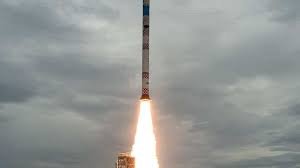12 Aug 2022 On the failure of ISRO’s maiden small satellite launch vehicle mission

- The Indian Space Research Organization (ISRO) launched the first flight of its new satellite launcher ‘Small Satellite Launch Vehicle (SSV)’ from the Satish Dhawan Space Center in Sriharikota, Andhra Pradesh, carrying two satellites – Prithvi. The observation satellite went into space carrying EOS-02 and Azadisat.
- However, these satellites sent with the launch vehicle failed to be placed in the desired orbit due to an error in their final stage.
What was the objective of the mission?
- The objective of this mission was to launch two satellites with the first launch of SSLV at a distance of about 350 km from the equator. It was to be placed in circular Low-Earth Orbit (LEO) at an altitude.
EOS-2:
- It is an optical remote sensing satellite designed and developed by ISRO.
AzadiSet:
- It was designed by the student team of ‘Space Kids India’ to measure the ionizing radiation which consisted of 75 small payloads.
- It was prepared as part of ISRO’s effort to popularize Science-Technology-Engineering-Mathematics (STEM) among girl students at school level where it inspires exploration of the universe.
Satellite launch failure
- The Small Satellite Launch Vehicle (SSLV) is a three-stage launch vehicle configured as a terminal stage with three solid propulsion stages and a liquid propulsion-based Velocity Trimming Module (VTM).
- The initial three stages of the launch were successful but the terminal stage of the Velocity Trimming Module (VTM) appeared to have a problem.
- According to the launch profile, the VTM should have been lit for 20 seconds.
- But it only burned for 0.1 seconds and failed to raise the rocket to the required height.
- According to ISRO, the satellites were placed in an elliptical orbit instead of a circular orbit and lost contact due to sensor failure.
Difference between circular and ellipsoidal orbits
Class:
- Orbit is the regular, repetitive path on which an object in space travels around another body.
Big circle:
- When a body moves around another body in an elliptical or elliptical path.
- Most of the planets in our solar system orbit in elliptical orbits instead of circular orbits due to the gravitational interaction of other planets and stars.
Circular:
- A circular orbit is an orbit of a fixed distance around the barycenter which is circular.
- Artificial satellites orbiting the Earth are usually placed in circular orbits.
- The circular path is favorable for artificial satellites because it is easier to take an image of the earth if the satellite is at a certain distance.
- Keeping the camera focused can become complicated if the distance varies (as in elliptical orbits).
Difference between SSLV and PSLV
Cost effective and payload capacity:
- SSLV is designed to launch 500-kg payload into 500-km planetary orbit and is less expensive than PSLV.
- Since the Polar Satellite Launch Vehicle (PSLV) can carry heavy loads, it does not have a high cost-benefit ratio in small projects.
Solid propellant:
- SSLV uses solid propellant and is more economical and easier to manage than PSLV’s liquid propellant stages.
Fast ‘Launch on Demand’ service:
- The long turnaround period (more than 60 days) of PSLV complicates ‘Launch on Demand’ launches.
- SSLV has the facility to launch multiple satellites. It has a low turnaround period (72 hours) and can be assembled within a fortnight, giving the space agency an opportunity to provide a ‘launch on demand’ service in the rapidly emerging low-Earth orbit launch area.
Upcoming Projects of ISRO
- Gaganyaan – Indian manned space flight programme.
- Aditya-L1: To study the atmosphere of the Sun.
- NASA-ISRO Synthetic Aperture Radar Mission: To study various threats and global environmental change.
- Shukrayaan-1: Orbiter for the planet Venus.
Future prospects
‘Doorway Commercial Satellite Launch Market’:
- SSLV is India’s official gateway to the worldwide commercial small satellite launch market.
- The rocket is believed to be operated by New Space India Limited (NSIL), India’s commercial space mission body.
- Attractive for commercial earth observation and communication.
Launching SSLV from Pole to Pole:
- ISRO intends to launch SSLV from Kulasekarapattinam (India’s new spaceport under construction) in Tamil Nadu in future.
- This will enable SSLV to enter pole-to-pole or polar orbit around Earth.
- This will allow SSLV to fly over Lakshadweep Sea without circling Sri Lanka, thereby saving fuel and payload capacity.
Steps towards Nano-satellite launch vehicle:
- With the advancement of technology there has been a significant reduction in the size of satellites where CubeSats and nano-satellites are becoming common.
- In this scenario, ISRO has the opportunity to lead the development of cost-effective nano-satellite launch vehicles.


No Comments